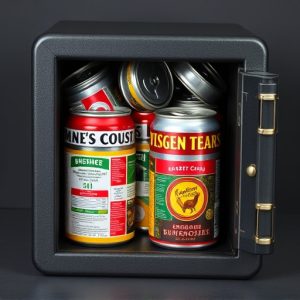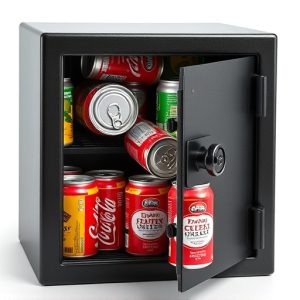Safe Disguised as Everyday Product Packaging: The Fake Peanut Butter Security Container Example
The "Fake Peanut Butter Security Container" is an innovative, disguised packaging solution…….
The "Fake Peanut Butter Security Container" is an innovative, disguised packaging solution that cleverly integrates a secret storage area within what appears to be a regular jar of peanut butter. This unassuming design offers discreet security for valuable items like documents and jewelry, seamlessly blending into everyday environments while deterring theft and unauthorized access. Its advanced locking mechanisms ensure the safety of high-value goods during transit and display, making it an ideal choice for protecting personal belongings in both home and office settings.
In an era where counterfeiting and product tampering pose significant risks, everyday product packaging is evolving into sophisticated hidden security solutions. This article explores the concept of disguised packaging, highlighting how seemingly ordinary items like the fake peanut butter security container can conceal secret compartments for enhanced safety. We delve into advanced technologies, specialized materials, and printing techniques that safeguard products while balancing consumer privacy concerns. Prepare to discover the future of secure packaging, where innovation meets discretion.
- Understanding Disguised Packaging: The Concept
- – Definition and purpose of hidden security solutions
- – How everyday products can mask secret compartments
- The Fake Peanut Butter Security Container Example
Understanding Disguised Packaging: The Concept
Disguised packaging, or stealth packaging, is a fascinating concept where everyday product containers are cleverly designed to conceal secret compartments or secure storage areas. This innovative approach has gained significant attention, especially in recent years, as it offers a unique solution for safeguarding valuable items or sensitive information. The idea behind this technique is simple yet ingenious: by mimicking the appearance of regular consumer products, these disguised containers can blend seamlessly into everyday environments, making them ideal for discreetly storing important documents, personal belongings, or even specialized equipment.
One popular example that highlights this concept is the “Fake Peanut Butter Security Container.” This cleverly designed product looks identical to a typical jar of peanut butter but secretly holds a hidden compartment for secure storage. It allows individuals to keep their possessions safe while maintaining an unassuming exterior, making it perfect for travel or scenarios where discretion is essential. Such disguised packaging offers a creative way to combine functionality with security, ensuring that personal items remain confidential and protected.
– Definition and purpose of hidden security solutions
Hidden security solutions, also known as disguised safety containers, are innovative products designed to protect valuable items while appearing as ordinary everyday items. These clever devices offer a discrete way to safeguard possessions, ensuring sensitive materials remain secure and out of reach from unauthorized individuals. By seamlessly integrating with common household or office items, such as a Fake Peanut Butter Security Container, these solutions provide an extra layer of protection without compromising aesthetics or practicality.
The primary purpose of such hidden security measures is to deter theft and prevent unauthorized access. By disguising a safe as everyday packaging, users can place their valuables within easy reach but keep them hidden from curious onlookers. This innovative approach allows individuals to secure items like documents, jewelry, or even small electronic devices without drawing unnecessary attention.
– How everyday products can mask secret compartments
Everyday products like peanut butter jars can serve as clever disguises for secret compartments, making them an unlikely yet effective choice for hiding valuables or sensitive items. A seemingly ordinary jar of Fake Peanut Butter Security Container can conceal a hidden space designed to accommodate small objects. This is achieved through innovative product design, where the interior of the jar includes a hollowed-out section, cleverly integrated into the appearance of the peanut butter itself.
By masking these secret compartments within common household items, individuals can create secure storage solutions that are easy to hide and access. The versatility of everyday packaging allows for discretely stowing away personal belongings, ensuring their safety while maintaining an unassuming exterior.
The Fake Peanut Butter Security Container Example
In recent years, a clever example of secure packaging has emerged in the form of the “Fake Peanut Butter Security Container.” This innovative design isn’t your typical jar of peanut butter; it’s a sophisticated security solution disguised as everyday product packaging. The container looks and feels like an ordinary peanut butter jar, complete with labels and branding, but beneath this facade lies a complex locking mechanism designed to prevent unauthorized access.
This fake peanut butter container utilizes advanced technology to secure valuable items within. By mimicking the aesthetics of common household products, it avoids raising suspicion when transported through security checks. This tactic not only enhances security for high-value goods during transit but also serves as a clever deterrent against theft in retail settings, where merchandise is often left unattended.
In today’s world, where security threats are ever-evolving, innovative solutions like disguised packaging offer a unique approach to protection. As demonstrated by the fake peanut butter security container example, everyday products can serve as clever concealment for sensitive items or confidential information. By integrating hidden compartments into seemingly ordinary containers, manufacturers provide an effective way to safeguard valuables while maintaining an unassuming appearance. This subtle yet powerful technology ensures that individuals and businesses alike can enhance their security measures without compromising on style or functionality.


